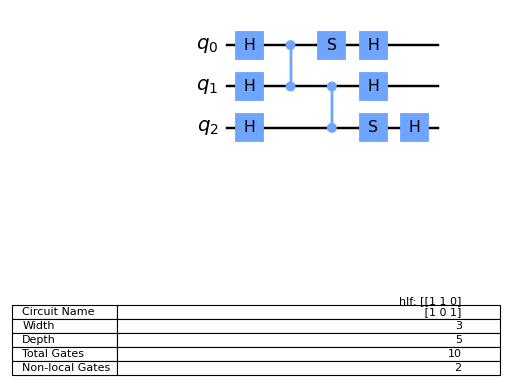HiddenLinearFunction¶
- class qiskit.circuit.library.HiddenLinearFunction(adjacency_matrix)[source]¶
Bases:
QuantumCircuitCircuit to solve the hidden linear function problem.
The 2D Hidden Linear Function problem is determined by a 2D adjacency matrix A, where only elements that are nearest-neighbor on a grid have non-zero entries. Each row/column corresponds to one binary variable \(x_i\).
The hidden linear function problem is as follows:
Consider the quadratic form
\[q(x) = \sum_{i,j=1}^{n}{x_i x_j} ~(\mathrm{mod}~ 4)\]and restrict \(q(x)\) onto the nullspace of A. This results in a linear function.
\[2 \sum_{i=1}^{n}{z_i x_i} ~(\mathrm{mod}~ 4) \forall x \in \mathrm{Ker}(A)\]and the goal is to recover this linear function (equivalently a vector \([z_0, ..., z_{n-1}]\)). There can be multiple solutions.
In [1] it is shown that the present circuit solves this problem on a quantum computer in constant depth, whereas any corresponding solution on a classical computer would require circuits that grow logarithmically with \(n\). Thus this circuit is an example of quantum advantage with shallow circuits.
Reference Circuit:
Reference:
[1] S. Bravyi, D. Gosset, R. Koenig, Quantum Advantage with Shallow Circuits, 2017. arXiv:1704.00690
Create new HLF circuit.
- Parameters:
adjacency_matrix (List[List[int]] | ndarray) – a symmetric n-by-n list of 0-1 lists. n will be the number of qubits.
- Raises:
CircuitError – If A is not symmetric.
Attributes
- ancillas¶
Returns a list of ancilla bits in the order that the registers were added.
- calibrations¶
Return calibration dictionary.
The custom pulse definition of a given gate is of the form
{'gate_name': {(qubits, params): schedule}}
- clbits¶
Returns a list of classical bits in the order that the registers were added.
- data¶
Return the circuit data (instructions and context).
- Returns:
a list-like object containing the
CircuitInstructions for each instruction.- Return type:
QuantumCircuitData
- extension_lib = 'include "qelib1.inc";'¶
- global_phase¶
Return the global phase of the current circuit scope in radians.
- header = 'OPENQASM 2.0;'¶
- instances = 161¶
- layout¶
Return any associated layout information about the circuit
This attribute contains an optional
TranspileLayoutobject. This is typically set on the output fromtranspile()orPassManager.run()to retain information about the permutations caused on the input circuit by transpilation.There are two types of permutations caused by the
transpile()function, an initial layout which permutes the qubits based on the selected physical qubits on theTarget, and a final layout which is an output permutation caused bySwapGates inserted during routing.
- metadata¶
The user provided metadata associated with the circuit.
The metadata for the circuit is a user provided
dictof metadata for the circuit. It will not be used to influence the execution or operation of the circuit, but it is expected to be passed between all transforms of the circuit (ie transpilation) and that providers will associate any circuit metadata with the results it returns from execution of that circuit.
- num_ancillas¶
Return the number of ancilla qubits.
- num_clbits¶
Return number of classical bits.
- num_parameters¶
The number of parameter objects in the circuit.
- num_qubits¶
Return number of qubits.
- op_start_times¶
Return a list of operation start times.
This attribute is enabled once one of scheduling analysis passes runs on the quantum circuit.
- Returns:
List of integers representing instruction start times. The index corresponds to the index of instruction in
QuantumCircuit.data.- Raises:
AttributeError – When circuit is not scheduled.
- parameters¶
The parameters defined in the circuit.
This attribute returns the
Parameterobjects in the circuit sorted alphabetically. Note that parameters instantiated with aParameterVectorare still sorted numerically.Examples
The snippet below shows that insertion order of parameters does not matter.
>>> from qiskit.circuit import QuantumCircuit, Parameter >>> a, b, elephant = Parameter("a"), Parameter("b"), Parameter("elephant") >>> circuit = QuantumCircuit(1) >>> circuit.rx(b, 0) >>> circuit.rz(elephant, 0) >>> circuit.ry(a, 0) >>> circuit.parameters # sorted alphabetically! ParameterView([Parameter(a), Parameter(b), Parameter(elephant)])
Bear in mind that alphabetical sorting might be unintuitive when it comes to numbers. The literal “10” comes before “2” in strict alphabetical sorting.
>>> from qiskit.circuit import QuantumCircuit, Parameter >>> angles = [Parameter("angle_1"), Parameter("angle_2"), Parameter("angle_10")] >>> circuit = QuantumCircuit(1) >>> circuit.u(*angles, 0) >>> circuit.draw() ┌─────────────────────────────┐ q: ┤ U(angle_1,angle_2,angle_10) ├ └─────────────────────────────┘ >>> circuit.parameters ParameterView([Parameter(angle_1), Parameter(angle_10), Parameter(angle_2)])
To respect numerical sorting, a
ParameterVectorcan be used.>>> from qiskit.circuit import QuantumCircuit, Parameter, ParameterVector >>> x = ParameterVector("x", 12) >>> circuit = QuantumCircuit(1) >>> for x_i in x: ... circuit.rx(x_i, 0) >>> circuit.parameters ParameterView([ ParameterVectorElement(x[0]), ParameterVectorElement(x[1]), ParameterVectorElement(x[2]), ParameterVectorElement(x[3]), ..., ParameterVectorElement(x[11]) ])
- Returns:
The sorted
Parameterobjects in the circuit.
- prefix = 'circuit'¶
- qubits¶
Returns a list of quantum bits in the order that the registers were added.
